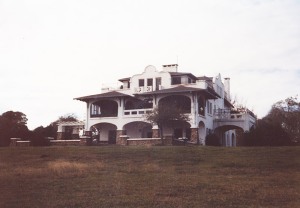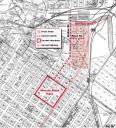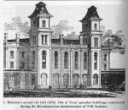
[Luna Park – 1924 newspaper advertisement]

[1920’s photo (looking west toward Luna Park) by Mary Bavouset, published with her permission in J.R. Gonazales’ Bayou City History blog]

[1920’s postcard of Houston showing Luna Park roller coaster in distance (top left)]

[Panoramic photo posted on HAIF by Kevin Jackson, reproduced from a panoramic photo that hangs or hung on the wall of the Harris County Smokehouse restaurant – the photo gives the park’s address as 2212 Houston Avenue]

[Detail from photo on cover of Houston Then and Now showing Luna Park coaster in distance (top center)]
Luna Park was an amusement park located in the Heights area – on Houston Avenue, on the banks of White Oak Bayou – in the 1920’s and early 1930’s. The park opened as Luna Park on June 26, 1924, though it may have been open under a different name before that, as images of the park purporting to be dated prior to 1924 exist. For example, the above panoramic photo of “Venice Park – Houston, Texas”, dated 1923, appears to show what became known as Luna Park.
A July 27, 1924 newspaper article described the park as follows:
The park has virtually every variety of amusement device known in the world of showdom. One of its biggest features is the giant skyrocket, a roller coaster larger and higher than any other operating in the United States. The skyrocket is a mile and a quarter long and at its highest point soars 110 feet in the air. The first drop on this mammoth devide is eighty-four feet. Some 2,500 to 3,000 persons ride the twelve cars of the big ride each night. Many other amusement devices dot the thirty-six acre park, which is located within five minutes’ ride from the heart of Houston. A monstrous seaplane swing also has been installed in the park, as has a caterpillar, a merry-go-round, dodgem, baby airplane swing, junior Ferris wheel, miniature railway and other devices.
Three shows now are operating. The Mysterious Sensation, a weird novelty, is proving the stellar attraction. Williamson’s Midget City, a show that has played at many fairs and expositions, also is operating. Another show, “See America First,” described as the latest sensation from Coney Island, is the third show now operating in Luna’s joy lane.
The park is featuring a picnic grove of several acres in area. Here more than a hundred rustic benches and tables have been installed. Picnickers throng the park every afternoon, there being a large number of fraternal, church and Sunday school picnics booked before the end of the summer season.
Luna Park will be an all-year resort, remaining open winter and summer. During the winter months the park’s big dancing casino will prove to be the main attraction. Free automobile parking within the gates is attracting many motorists to the playground each night.
The park’s “scenic railway” was reported to be two feet higher than Coney Island’s, and the dance pavillion was at the time the largest in the south. Luna Park also hired stunt flyer Francis H. Rust to stage night-flying stunts overhead.
Tough Times
Nearly as soon as it opened, however, Luna Park was a center of controversy. A lawsuit was filed against it in July 1924, by a woman who said she was “roughly treated” while standing in line for the roller coaster. She claimed that a park employee “caught her by the arms and desisted only after the crowd threatened to lynch or mob him.”
The park was sued again that August, for noise pollution. A Heights resident complained that “sleep is impossible” when the park’s roller coaster and other devices are operating, though the park’s witnesses testified that the street cars along Houston Avenue made far more noise than all the attractions combined.
Also in August 1924, a local newspaper reported:
The Mexican consulate in Houston may be closed in protest against “discriminatory tactics” against Mexicans, according to Consul H. Valdez. The protest grew out of the arrest and beating of a Mexican boy Wednesday night, after he had been refused admission to the Luna Park dance floor. The boy is Jesus Prieto Laurens, a graduate of Ohio University. He escorted to the dance a prominent Mexican girl, who recently won a beauty prize offered by the Salesmanship Club. He was sold tickets, but was not allowed to enter the dance hall, and when he asked for an explanation he was arrested and charged with assault. While being taken to the police station, the boy says, he was beaten and cursed. His brother, G. Prieto Laurens, former consul here, was held off at the point of a gun when he attempted to aid his brother, it was stated. Another brother of the boy formerly was mayor of Mexico City and governor of the state of San Luis Potosi. The grand jury today began an investigation of the case.
Houston Deputy Constable Frenchy Naquin was charged with assault in the matter, but was ultimately acquitted. At the time he was acquitted, he was also standing charges for assault on a man who was a “keeper of a parking place” near Luna Park.
Sadly, the history of Luna Park soon darkened further. On a single afternoon in October 1924, in two separate incidents, three people died at the park. A professional parachutist, Montie LeMay, was killed when her parachute failed to open. At nearly the same time, Mary Alta Watson and Charles C. Johnson were killed in a fall from the Luna Park roller coaster.
A year later, in August 1925, the Rice Hotel’s barber was stabbed several times at Luna Park.
Happier Days
However, the park remained a popular attraction, as demonstrated by a newspaper report on the Labor Day events of 1925:
The sturdy hands that provide the skill and man power to carry on Houston’s vast trade and industry were busy today at sports, atheltics and amusements at Luna Park. Between 10,000 and 15,000 members of labor unions and crafts, their families and friends thronged into the park throughout the day to enjoy the Labor Day festivites arranged in their honor. There were wrestling and boxing matches in the mammoth inverted bowl of a dancing casino, beginning at 1 p.m. Then there were races and other contests, with prizes to the winners; children’s games; awards to the best looking woman, the oldest couple, the fattest, the tallest, the shortest, the ugliest, and so on. Diving horses performed at 8:30 and 10:30 p.m.
A month later, the Houston and Galveston chapters of the Red Men fraternal organization held a joint “powwow” at the park, described as “one of the most spectacular and interesting of the typical celebrations held under the auspices of Texas Red Men.” The meeting featured “an outdoor initiation and war dance staged by the Galveston degree team in full regalia.” The war dance was staged just after dark, in the picnic grove, which was “appropriately lighted.”
By 1928, even the Mexican consulate appears to have made its peace with Luna Park. In observation of Mexican Independence Day, the consulate organized a two-day program at the park featuring “patriotic speeches, patriotic music; several entertainment features; and a reading of the Mexican Declaration of Independence.”
Marathons
Another noteworthy event in 1928 was a dance marathon at the dance casino:
Fifteen couples and a lone youth shuffled about the Luna Park dance casino today, the third day of a marathon which so far has seen the elimination of only five couples. One little blonde was eliminated from the marathon by her husband of three weeks who went to the dance hall last night. She argued with him, holding the hope of a “first payment on a home” with the prize money, but friend husband was obdurate, and home with him she went. One mother sat up all last night, holding a shoe box in her lap with food and first aid equipment to minister to her daughter who milled about in the long grind. The lone boy will be allowed ten hours, and unless a partner is provided, he will be ruled out. If some girl survives a boy partner in the grind, he will draw her for a partner.
Surprisingly, a report following several days later found the dance marathon still in progress:
Twenty-three pairs of blistered, burning feet were still shuffling about the Luna Park dance hall today in the dance marathon which started a week ago from from last Thursday. There are thirteen boys and ten girls still in the long grind; the three boys being without partners, who succumbed to weariness. The marathon has become grim business; the contestants rush to their cots for the fifteen-minute rest periods each hour; and sleep till roused. Some doze on their feet as they dance. The contestants are spurred on by $1,000 in prize money, three-fourths of which will go to the winning couple.
As the third week of the dancing marathon began, it was reported that the dancers were “continuing by dint of much smelling salts and determination.” But the marathon was clearly taking a toll on its participants:
Two girls, Phyllis Dreyer and Lucille Nelson, fainted last night on the floor, but were revived within the alotted five minutes by nurses and continued the grind. Fred Bradford fell asleep while dancing and tumbled forward on the floor, bruising a knee. He started dancing again, and shuffles along with a limp. Two of the stonger contestants aided Jean Inglehart to stay on his feet last night after he fainted, until he recovered sufficiently to proceed under his own power. The contestants help each other, rather than trying to get them out. The dancers shuffle for forty-five minutes and then rest fifteen in each hour.
The dancing marathon was apparently a promotional success, as a “floating marathon” was scheduled in the park in 1929, and a water tank constructed specially for the event. The floating marathon was billed as the first ever held in the state, and possibly in the world – the winner was to be named the floating champion of the world. Early favorites were 300-pound Tony Roselli and “star long distance swimmer” Lee Colombo.
Park Closes
But the 1930’s brought a return of the park’s early bad luck. In 1930, a man was discovered dead in the picnic grounds, his body having “apparently been there for several days” before police received an anonymous tip. And, in 1932, a Webster farmer was hijacked in his car outside Luna Park. It is unclear exactly when, but the park appears to have closed sometime in the early 1930’s, perhaps a victim of the Great Depression.
More information:
HAIF discussion re Luna Park
Another HAIF discussion re Luna Park
SixFlagsHouston.com discussion re Luna Park
PBS special that includes Luna Park





































